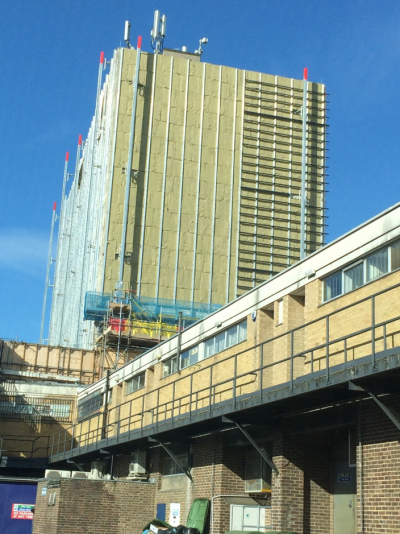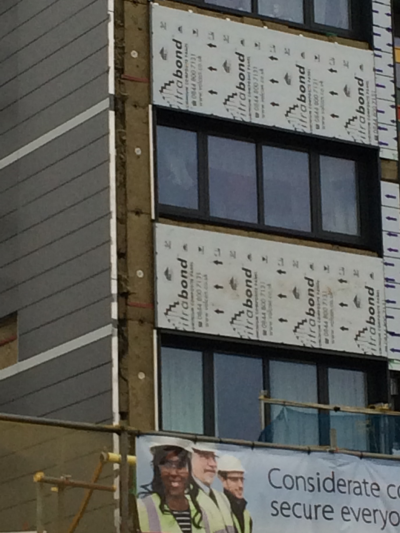Getting the cladding replaced
This blogpost follows an earlier one that looks at how to make private blocks safe. It is based on a talk given at an APPG Cladding Forum on 18th July. The focus is on what legal powers of enforcement there may be for leaseholders. There are around 300 private blocks that have cladding that has failed the BRE tests on combustibility (and 170 still to be tested). Work has commenced on very few of these, and with many blocks there are no plans yet in place to remove – and replace – cladding and insulation.
Posted:
Time to read:
The Government has charged developers with the responsibility to come up with proposals. The Housing, Communities and Local Government Committee has recommended the introduction of a low-interest loan scheme for building owners to ensure that the work is done but that costs are not passed on to leaseholders. It also says that there should be a ban on combustible cladding on existing buildings over 18 metres (not only new build) and that the ‘Government should fully fund the replacement of any cladding on existing buildings’.
But what can leaseholders do if there is continuing inaction? Financing – who pays – is clearly an issue, but it is not the only issue.
Throughout the process many leaseholders have had no voice. Both the HCLG Committee report and the Hackitt review argue that residents ‘require a more meaningful voice’. They are the ones living with the fire risk, in flats that are devalued, and are unable to move on with life plans – and yet they are not being listened to or consulted. Even in blocks where it looks like there may be action, such as NCQ following the recent announcement that the NHBC will pay for remediation work, leaseholders still do not know what this means and what will be done to their buildings, and whether they will be safe.
This blog looks at two issues:
- Who has the power to replace the cladding?
- What can be done if they are not doing anything about replacing it?

- Who has the power to replace the cladding?
This first question can be shortly answered. The power to do something lies with the freeholder, the block owner, or sometimes the managing agents (as in the Citiscape case that involved what is called a ‘tripartite’ lease). Sometimes the freeholder is a company owned by the leaseholders – the leaseholders then have the ability to take action, but this raises other, very tricky, issues not focussed on in this blog. Here I am looking at the cases – probably more common – when the block is owned by an independent freeholder, such as Galliard Homes at NCQ. Ownership and responsibility are complex questions – it is not clear that this is even fully understood in the HCLG report that wrongly states that long leaseholders are ‘often the only parties with a contractual obligation to carry out remedial works’. It is NOT the leaseholders who can replace cladding.
- So what can be done if they are not doing anything about replacing it?
In law there is a distinction between private and public law – private law concerns relationships between private individuals (including companies), and public law looks at the relationship between individuals and the state. This is a helpful way of thinking about routes of action open to leaseholders.
In private law there are various possible options, depending on individual circumstances:
- First, using the lease to make the freeholder/managing agent do the work. This is going to be difficult. Most leases place the freeholder under a duty to repair the building – it may sound obvious that defective cladding is not in good repair – but it is not a straightforward point of law. It will always depend on the wording of the particular lease. In Citiscape the leases referred to keeping in ‘good and substantial repair, order and condition’ and making good ‘inherent structural defects’. On this wording, the judge said that it appeared to cover the removal and replacement of the defective cladding. But this is a decision of the First Tier Tribunal; it has no precedent value; and it turns on the particular wording in the particular lease.
- The second possible private law action involves using the Defective Premises Act 1972. This places a duty on a person who does work in connection with providing a dwelling to ensure that the dwelling is fit for habitation. Developers may seek to argue over the meaning of fitness for habitation – and there is relatively little case law on this – but surely buildings with cladding that fail building regulations are not fit for habitation. Unless the builder agrees in a settlement to fix the cladding, the remedy for breach is likely to be damages – leaving leaseholders with money but still with the problem of how to get the work done. It will not help with older buildings – there is a time limit for bringing action of 6 years from completion.
- It may be possible to bring an action in contract law if the flat owner has bought from the developer. This might work if the contract contains warranties about compliance with building regulations – but not all do. It is difficult to see how the remedy could be replacement of cladding, as this affects the whole building – the more obvious remedy would be damages for the individual claiming. It can only help the original purchaser, and probably only if bought off-plan and, again, only if the action is brought within 6 years.
- Finally, there may be building warranty insurance, such as NHBC. Again, this will only help the newer buildings (it covers the first 10 years).
With all of these private law actions there are going to be challenges – as well as difficult points of law, there are difficulties in bringing groups together for collective action, agreeing the legal strategy, and funding litigation. And much of this is being done in the face of silence from those who have the information about the building that is simply not being passed on.

Public law looks at the relationship between individuals and the state. There are various state actors involved – or who could be involved – in cladding issues. To date they have generally adopted a conservative stance towards their powers, and responsibilities are fragmented among national and local government and fire authorities.
- Perhaps the most obvious body – the most visible – are the fire authorities. Under the Regulatory Reform (Fire Safety) Order 2005, Fire Authorities have duties and powers to issue enforcement or prohibition notices. In practice, what they have largely done is to acknowledge that there is a risk to life and to require ‘stay put’ buildings to change to ‘simultaneous evacuation’ with interim measures, such as fire wardens. They have not been willing to use their powers to require cladding to be removed – and they have adopted a very conservative (and questionable) understanding of what powers they have under the Fire Safety Order.
As well as the fact that this is not getting the cladding sorted, there are other problems with this response. First, the change to simultaneous evacuation is not without risk. As evidence at the Grenfell inquiry shows, evacuating a building which was designed for stay put is not going to be easy. It is likely to delay rescue and fire-fighting. Second, national guidance is that interim measures should only be temporary. The solution should be to sort out the cladding. But fire authorities have adopted a cautious interpretation of their powers, stating that ‘[w]hile interim measures are in place it is very doubtful that the premises are non-compliant or, even if they were, that there is a risk that it was reasonable for a regulator to address through formal enforcement action.’ This has to be questioned – and is flatly inconsistent with the approach in the guidance issued by the National Fire Chief’s Council.
-
Local authorities also have powers. Under the Housing Act 2004 they can serve improvement notices if there is a housing hazard. They can also use acquisition powers. There is an example of both. Medway has served an improvement notice for The Hamptons, and Slough has agreed with the freeholder that it will acquire control of Nova House. But the majority of councils have not taken action to require cladding to be replaced. Why? First, they show deference to the role of the Fire Authorities under protocols that have been reached. Second, they give insufficient weight to health and safety issues – again, like the fire authorities, viewing the interim measures as sufficient to protect against risk to life. Third, they appear to prefer informal engagement with the building owners. Finally, they appear to have close working relationships with industry – but are not engaged with leaseholders.
- National and local government also have ‘soft’ powers they can use to nudge the industry towards faster action. We are not seeing these being used yet.

Finally, what can be done if these public bodies are not exercising the powers that they have to get something done?
Article 2 of The European Convention on Human Rights gives a right to life, and public authorities are under a positive obligation to protect these rights. Under section 3 of the Human Rights Act 1998 there is a requirement for laws, such as the Fire Safety Order and Housing Act, to be interpreted to facilitate protected rights. In combination, this means that claims can be brought against public authorities for failure to protect Article 2 rights. There is, again, the problem of how leaseholders are to manage litigation – but here there is the possibility for class action involving multiple blocks.
This positive obligation to act also applies to national government. Looking backwards, it may well be that the failure to have in place an effective regulatory system for building standards and fire safety involves a breach. In the present, the least that it should be doing is providing effective leadership to other parts of government to be proactive and prioritise the protection of the health and welfare of residents. All of government has to aspire to do better.
__________
How to cite this blog post (Harvard style)
Bright, S. (2018). Getting the cladding replaced. Available at: https://www.law.ox.ac.uk/housing-after-grenfell/blog/2018/07/getting-cladding-replaced (Accessed [date]).
Share:
